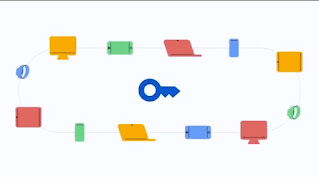[ad_1]
You understand what I hate? I imply actually hate? Passwords is without doubt one of the issues I hate. There are too a lot of them. They’re exhausting to maintain up with. I am shedding them on a regular basis. I will exit on a limb, in all probability not very far, and counsel that you just in all probability don’t love them both.
Nicely, what if I informed you there was a means that we might eliminate these items with out compromising safety? The truth is, a means that permits us to enhance usability of the system whereas additionally bettering safety, which is one thing that is exhausting to do, each of those on the similar time.
That might be fascinating, proper? What is the title of the expertise that lets us do that? This expertise is named Quick Identification On-line (FIDO).
- F – Quick
- ID – Identification
- O – On-line
What does FIDO do?
FIDO is a protocol that permit us eliminate passwords by changing them with one thing we name passkeys. And it isn’t one thing model new, though you might not have heard of it earlier than. It has been round since 2013, the FIDO Alliance, this trade consortium that put collectively the usual. The truth is, there are greater than 250 organizations which might be utilizing the FIDO customary and are a part of this alliance.
There is a newer model of FIDO known as FIDO2, which includes two new parts which might be significantly vital.
One in all this component is hardware-based authentication. With hardware-based authentication, I can use biometrics or hardware-based tokens, assume a telephone that’s one thing I’ve, after which utilizing my face to unlock the telephone, one thing that I’m, that we will do this type of factor.
The second component FIDO2 have is help for net browsers, which now extends the use circumstances and the opportunity of all of the completely different locations the place we will use FIDO.
How Does FIDO Works
How does all this magic work? Nicely, let’s begin with a fast overview of cryptography. A few of these ideas are going to be vital in understanding how this may very well be potential. Initially, we’ve got two major completely different courses of cryptographic algorithms.
- Symmetric Cryptography Algorithm
- Uneven Cryptography Algorithm
With the symmetric algorithm, I’ve a single key, a symmetric key, and that secret is used to encrypt in addition to decrypt. So if I encrypt a message, I take advantage of this key, I need to decrypt it, I take advantage of the exact same key. So which means either side should have that key and know what it’s. That is how symmetric cryptography works, its known as symmetric as a result of it is the identical key on either side.
Nonetheless, after we go over to uneven cryptography, it is a completely different scenario. We’ve got two mathematically associated keys that share this distinctive property that no matter I encrypt with one can solely be decrypted with the opposite, and vice versa. If I encrypt with this, then I can decrypt solely with that. So, these are associated, however they don’t seem to be equal.
Now, we will use that particular high quality to be able to do the magic that we will do with these passkeys. As an example, the truth is what we do, we refer to those, certainly one of them as a public key and the opposite as a non-public key.
So, let’s take an instance of how we’d use these. Assuming we’ve got a customers who needs to login to explicit web site. Initially, they should register. How does the registration circulation work? Nicely, it is type of like this, person goes to ship some registration info over to the net server. And as they’re doing that on this means of registration, the person on their gadget goes to generate each a public key and a non-public key.
The non-public secret is going to remain on person’s gadget and by no means depart it. And its going to be locked down with some type of biometric or different sturdy authentication functionality. So the non-public key stays on the gadget.
The general public key, nonetheless, we share with the net server, the net server takes that public key and places it in a database and associates it with this person. Now that is the registration section.
Now what can we do subsequent is, to illustrate, the person needs to log into the system. So what we’d like to have the ability to do is authenticate. The authentication circulation goes to work like this; the person goes to ship info to the net server, as an example, they will put of their username and say, hey, that is me, I might wish to log in.
The online server says, oh yeah, I bear in mind you since you registered with me earlier than. I will pull in your public key since you shared that with me beforehand. (And by the way in which, there’s by no means an issue with sharing a public key. That is why we name it a public key. The one drawback is if you happen to share a non-public key).
So, we take the general public key that is beens shared upfront, and we will then calculate a problem of some type, CNAL. That could be a specifically designed message that is going to have some info, in all probability a timestamp and different issues like that, which might be distinctive. And we will encrypt it with that person’s public key.
That is the place we begin getting the true safety capabilities. He sends the problem over to the person. The person decrypts it with their non-public key, after which in the event that they’re capable of learn it, they’re to see what is the problem message and so they can then reply to the net server encrypting the response that proves that they’ve learn the problem message and they’re going to encrypt that once more with their non-public key and ship that again to the net server.
The online server then goes to take that, and we do the ultimate step, that’s verification. Verification means the net server now could be going to take this response message that we bought, We will decrypt it with the general public key and we will evaluate it and see if it really works.
If the problem we despatched matches the message we bought again, then we will show that this person is the truth is who they declare to be and we are going to permit them to log in. Discover what was not ever occurring on this case. There have been no passwords. At no time did you see a password come out of my arms.
On this case, we saved the non-public key on the gadget at all times, we hold the general public key, share it with the net server, the net server associates that with the person, after which we simply do a sequence of challenges. So for this person, all they should do so as, when this problem comes throughout, unlock their gadget, point out perhaps on the gadget that that is the web site I need to log into, approve that, and the remainder of it occurs routinely.
Conclusion
Let’s overview actually rapidly what we have talked about. So with FIDO, we hold the non-public key on the gadget itself, and we guard it with multi-factor authentication. In order that means, no one else can see it, it stays non-public, and subsequently solely that person can decrypt and encrypt with that key. The general public key, nonetheless, is shared. That is why we name it public.
We share that with the service supplier, with the web site, or what have you ever. And that is okay, due to the mathematical relationship between these two. Having one does not permit you to work out what the opposite is, which is sweet.
Now, one of many issues that is very nice about this, not solely do I get to eliminate passwords, however there’s some downstream results that happen from that. As an example, it resists phishing assaults. So the phishing subject usually happens as a result of somebody is ready to coax you out of your credentials. You click on on an internet site and log right into a bogus web site and also you give the attacker your login, your person ID and password.
If there is not any password, in different phrases solely move keys within the type of these challenges and crypto mechanisms, then there actually is not any password for the phisher to assemble within the first place. So we resist a number of these phishing assaults. That is a pleasant facet impact.
One other factor is it resists replay assaults. So, a replay assault is one the place a person or an attacker would possibly sit on a community and see the knowledge that you just’re sending. If you go to ship your password over the community, perhaps it is in an encrypted type, within the type of a hash, and so they take that hash and so they do not even should know what it says, they only want a replica of it, after which they replay it and ship it to the net server as in the event that they had been you. On this case, we have a system of challenges. They would not know what to ship as a result of they’d should see what was coming within the first place. So we resist replay assaults.
And eventually, it removes passwords for us. these issues that we hate, the issues which might be exhausting to maintain up with, the issues that may be forgotten, the issues that individuals write down, the issues that individuals are not very inventive at arising with within the first place. In this type of a scenario, there is not any passwords concerned. The previous keys are all primarily based upon info with these private and non-private keys, that are routinely generated, and so they’re advanced and robust, and the person does not should sustain with it. And you understand what, this has been round for some time.
The truth is, IBM has been supporting FIDO2 since 2018. And there is a number of different distributors which might be leaping on board as properly, as I informed you to start with. So, that is one thing that I imagine goes to be the way forward for logins and authentication and the gorgeous factor is, the long run is freed from passwords. Thanks for studying. If you happen to discovered this publish fascinating and wish to be taught extra about cybersecurity, please bear in mind to share this publish and observe the Blueguard.
[ad_2]






